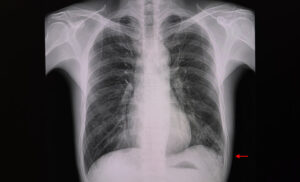Pleural diseases affect the pleura, two layers of protective tissue that serve as the lining of the lungs. If someone inhales toxic substances like asbestos, it may irritate the pleura and cause diseases like mesothelioma. U.S. veterans are at a higher risk of pleural diseases since the military relied on asbestos for decades. Thankfully, treatments and military benefits may be available to those affected.
How Asbestos Causes Pleural Diseases
Once it’s lodged in the body, asbestos causes pleural diseases through decades of irritation to the lung lining. This irritation can lead to scarring, fluid buildup, cancer, or other health problems.

Asbestos is a highly durable — but dangerous — material once used to make thousands of products, ranging from construction materials to car parts. If products made with asbestos wear out or get damaged, tiny asbestos fibers are released into the air. Those nearby may then inhale these fibers, which make their way into the pleural space and can get stuck inside.
The human body cannot break down asbestos fibers, so they remain may inside the body. Over time, the fibers can cause severe damage to the pleura, eventually leading to the formation of cancer or other noncancerous diseases.
Asbestos-related pleural diseases include:
- Mesothelioma, a rare but deadly cancer
- Pleural effusions, fluid buildup in the pleura
- Pleural plaques
- Pleural thickening
- Pleurisy
- Pneumothorax
We may be able to help you or a U.S. veteran with asbestos-related pleural diseases get compensation, justice, and benefits. Get started now.
U.S. Veterans at Risk of Asbestos Pleural Diseases
U.S. veterans who served between the 1930s and the early 1980s are at a higher risk of asbestos-related pleural diseases.
Video Summary: In this video, VA-accredited attorney Eric Hall explains why U.S. veterans are at risk of asbestos-related diseases like mesothelioma. He also breaks down how affected veterans can access military benefits and medical treatment. Call (877) 450-8973 to get started. View Transcript
Veterans who served in the military between the 1930s and the 1980s were likely exposed to asbestos while they were on active duty. Usually, if you've developed an asbestos-related disease, you developed that disease because you had an excessive amount of exposure to asbestos.
If a veteran believes they were exposed to asbestos while serving in the military, we encourage them to call the Mesothelioma Veterans Center so that we can work together to help them file for VA benefits.
The VA will recognize any asbestos-related disease as long as your asbestos exposure happened while you were on active duty in the military.
In addition to VA benefits, the Mesothelioma Veterans Center can connect veterans with world-renowned physicians and nurses on staff that can answer any of your treatment questions. We encourage veterans to call and find out how we can help them.
During that time, the U.S. military relied on asbestos-based products as they were cheap and fireproof — without realizing that asbestos can lead to pleural diseases. The makers of asbestos-containing products knew of the risks but hid them to keep profits high.
U.S. veterans make up around 33% of all mesothelioma diagnoses as a result of corporate negligence. Most mesothelioma cases develop in the lung lining (pleura).
Veterans who develop asbestos-related pleural diseases stemming from their military service can pursue benefits from the U.S. Department of Veterans Affairs (VA). The VA offers health care and monthly payments to veterans who got sick from military asbestos exposure.
U.S. veterans and civilians can also pursue legal compensation from manufacturers if they develop asbestos-related pleural diseases.
Our team can help you file for VA benefits if you or a loved one develops a pleural disease like mesothelioma after serving in the military.
Types of Asbestos-Related Pleural Diseases
Pleural Mesothelioma
Pleural mesothelioma is a cancer that starts in the lung lining and is only caused by asbestos exposure.
Asbestos causes pleural mesothelioma by irritating healthy cells in the lung lining. After 10-50 years, this long-term irritation causes healthy cells to mutate into cancer cells. The cancer cells then divide at an out-of-control rate, causing pleural tumors to form in the chest wall.
Common symptoms of pleural mesothelioma include:
- Breathlessness
- Persistent cough
- Rib, shoulder, or back pain
- Weight loss
Walter served in the U.S. Navy for 20 years and was exposed to asbestos through his work as a boiler tender during this time. Over 40 years after his service, Walter developed recurring bouts of pneumonia and other symptoms. An X-ray revealed a cancerous mass in his lungs. Walter had pleural mesothelioma.
Pleural mesothelioma is not to be confused with asbestos-related lung cancer, which affects the lungs themselves. Though there is no cure, treatments can often help pleural mesothelioma patients live longer and ease their symptoms.
Pleural Effusion
A pleural effusion occurs when there's an excess buildup of fluid in the lining of the lungs. The pleural space typically contains a small amount of fluid to help the layers of the pleura move properly as someone breathes.
However, fluid can build up if the pleura becomes irritated. This may lead to symptoms such as difficulty breathing or a chronic cough.
Over 90% of patients with pleural mesothelioma will suffer from pleural effusions.
Blood and lymph fluid can build up in the pleura too. This can lead to subtypes of pleural effusions.
Pleural effusion subtypes include:
Chylothorax
This is a pleural effusion where chyle (lymph fluid formed in the small intestine) fills the lung lining. Chylothorax may be a sign of pleural mesothelioma in rare cases. The journal Respirology Case Reports noted that a 34-year-old woman was diagnosed with mesothelioma after suffering from recurring bouts of chylothorax.
Hemothorax
Hemothorax, also known as a hemorrhagic pleural effusion, occurs when blood builds up in the pleura. The U.S. National Library of Medicine notes that this condition causes many symptoms, like shallow breath, chest pain, and a rapid heartbeat.
Pleural Plaques
Pleural plaques are white, chalky clumps of a protein called collagen that form in the lining of the lungs. It is the most common asbestos-related pleural disease, according to Cancer Therapy Advisor.
Unlike most other pleural diseases, pleural plaques are usually harmless. They typically don't cause symptoms and do not require treatment. However, those with pleural plaques are still at risk of other pleural diseases like mesothelioma as they've been exposed to asbestos.
The VA has awarded benefits to veterans who developed pleural plaques stemming from military asbestos exposure in several past cases. See if you can file for VA benefits with help from our team.
Pleural Thickening
Pleural thickening occurs when the lung lining becomes scarred due to long-term irritation from asbestos fibers. This scarring limits the pleura’s ability to move and leads to difficulty breathing.
Pleural thickening can be caused by asbestos exposure or indirectly by other asbestos-related diseases like pleural effusions. Fortunately, the symptoms of pleural thickening are usually mild, so treatments aren’t typically needed.
Pleurisy
Pleurisy, also known as pleuritis, is the inflammation of the pleura’s two layers. 

The main symptoms of pleurisy are shortness of breath and chest pain. Some patients may also experience purulent pleuritis or empyema, in which pus collects in the pleura.
Pleurisy responds well to treatments in most cases, but it may come back if it’s caused by an underlying health problem like cancer.
Pneumothorax
Pneumothorax occurs when air builds up in the pleura. In severe cases, an excessive amount of air causes the lungs to collapse.
Symptoms of pneumothorax include:
- Chest pain
- Cyanosis (skin turns blue due to lack of oxygen)
- Difficulty breathing
Multiple cases have been reported where people suffering from pneumothorax were later diagnosed with pleural mesothelioma.
Asbestos Pleural Disease Symptoms
While pleural diseases vary in their severity, many share similar symptoms. The symptoms of most asbestos pleural diseases typically develop 10-50 years after asbestos exposure.
Common symptoms of pleural diseases include:
- Chest pain
- Chronic cough
- Difficulty breathing
- Shortness of breath
- Weight loss
If you may have symptoms of an asbestos-related pleural disease, seek medical care immediately. You may have a better health outlook with a prompt diagnosis and treatment — particularly if you have pleural mesothelioma.
Get help pursuing compensation for asbestos-related pleural diseases now.
Diagnosing Pleural Diseases
If health care professionals think you have an asbestos-related pleural disease, they’ll perform a series of tests. These tests allow doctors to see any abnormalities like scarring, a collapsed lung, fluid buildup, or possibly cancerous tumors.
To diagnose pleural diseases, doctors typically use:
- Chest X-rays: An X-ray uses low doses of radiation to create an image of the chest’s internal structure.
- Computed tomography (CT) scan: A CT scan is a more in-depth type of X-ray that’s guided by computers. It allows doctors to create a three-dimensional image of the chest.
- Other tests: Ultrasounds, blood tests, or positron emission tomography (PET) scans may be used to help see inside the chest.
If doctors suspect you may have cancer, they will perform a biopsy by taking a fluid or tissue sample and testing it for cancer. A biopsy is the only way to confirm a mesothelioma cancer diagnosis.
Prognosis of Pleural Diseases
The prognosis (expected health outlook) of pleural diseases varies greatly depending on which condition you have.
For example, pleural plaques produce no symptoms and don't harm the patient, so the prognosis is good. Pleurisy and pleural thickening cause mild symptoms but they usually don’t affect overall lifespan.
Potentially fatal pleural diseases include:
- Pneumothorax: If there’s only a small amount of air in the pleura, a pneumothorax isn’t life-threatening. However, if a lot of air enters the pleura, the lungs and heart can get compressed and the patient may die from respiratory failure.
- Pleural effusions: Those with malignant pleural effusions had a median survival of 21 months or less, according to a report from BMC Pulmonary Medicine.
- Pleural mesothelioma: Pleural mesothelioma is the most dangerous of all pleural diseases and has a poor prognosis. The average pleural mesothelioma life expectancy is 12-21 months.
Patients with these dangerous pleural diseases require critical care from doctors. Find top pleural mesothelioma doctors now.
- Alabama
- Alaska
- Arizona
- Arkansas
- California
- Colorado
- Connecticut
- Delaware
- Florida
- Georgia
- Hawaii
- Idaho
- Illinois
- Indiana
- Iowa
- Kansas
- Kentucky
- Louisiana
- Maine
- Maryland
- Massachusetts
- Michigan
- Minnesota
- Mississippi
- Missouri
- Montana
- Nebraska
- Nevada
- New Hampshire
- New Jersey
- New Mexico
- New York
- North Carolina
- North Dakota
- Ohio
- Oklahoma
- Oregon
- Pennsylvania
- Rhode Island
- South Carolina
- South Dakota
- Tennessee
- Texas
- Utah
- Vermont
- Virginia
- Washington
- Washington DC
- West Virginia
- Wisconsin
- Wyoming
Speak with our trusted advocates to learn more about mesothelioma specialists in your state.
Pleural Disease Treatment Options
Doctors treat asbestos-related pleural diseases using different methods depending on the type of disease a patient has.
Treatments for pleural diseases may include:
Chemotherapy
Chemotherapy is a type of medication used to kill cancer. Pleural mesothelioma is typically treated using a combination of two chemotherapy drugs: pemetrexed and cisplatin.
Extrapleural Pneumonectomy (EPP)
An extrapleural pneumonectomy is one of two major surgeries used to treat pleural mesothelioma. All visible cancer tumors, the lung closest to the cancer, the pleura, and other cancerous tissues are removed.
Pleurectomy With Decortication (P/D)
A pleurectomy with decortication is another surgery used to treat pleural mesothelioma. It’s an alternative to the EPP in which doctors remove the pleura and cancerous growths but not the lung itself.
Pleural Catheters
If you have pleural effusions that keep coming back, doctors can insert a catheter into the chest cavity. You or your loved one can then drain the pleural fluid at home.
Radiation
Radiation therapy may be used to treat pleural mesothelioma. Doctors use high-energy X-rays to kill cancerous cells in the lung lining.
Talc Pleurodesis
Here, doctors drain the pleural space and then insert medical-grade talc into it. This causes the two linings of the pleura to stick together, preventing fluids or air from building up. It may be used to treat a pneumothorax or a pleural effusion.
Thoracentesis
Doctors use a thoracentesis to drain excess fluid from the pleural cavity, which helps improve the patient’s breathing and reduces pain. It can also be used to extract a fluid biopsy if the patient might have cancer.
Thoracostomy
This treatment is similar to a thoracentesis. It involves doctors inserting a small tube into the pleura to suck out air or fluid. This makes it a good treatment for pneumothorax or pleural effusions.
Other Treatments
Doctors can recommend other treatments like medications and minor surgeries depending on the needs of the patient. New treatments may also be available in clinical trials taking place throughout the country.
The success of these treatments can vary by patient and the type of disease they have. In cases of pleural mesothelioma, long-term survival even with treatment is rare — but some patients have beaten the odds and lived for decades.
We can help you afford treatments for asbestos-related pleural diseases right now if eligible.
VA Benefits & Compensation for Pleural Diseases
U.S. veterans who have developed a pleural disease stemming from their military service can pursue military benefits and other resources. Learn more below.
VA Benefits
By filing for VA benefits, veterans may be able to receive almost $4,000 a month for veterans with mesothelioma or other asbestos-related diseases in many cases.
Veterans may also qualify for VA health care, allowing them to access low-cost or free medical treatments from some of the world’s top doctors.
See if you can file a VA benefits claim now with our team's help.
Asbestos Legal Claims


While filing a claim may seem hard, asbestos attorneys do most of the work so there is no extra stress on the veteran. Further, no legal action will be taken against the U.S. military or government.
Connect with a mesothelioma attorney to see if you qualify to file an asbestos legal claim.
Asbestos Trust Funds
Many companies that made asbestos-based products filed for bankruptcy to shield themselves from legal claims. While these companies can’t be sued, they were forced to set up trust funds so victims could get compensated.
An estimated $30 billion is available in asbestos trust funds and veterans can work with an attorney to determine whether they can access a portion of this money.
Get Help for Asbestos-Related Pleural Diseases
U.S. veterans who served their country never deserved to develop pleural diseases like mesothelioma or pleural effusions. Sadly, thousands of veterans continue to suffer from these illnesses every year.
Fortunately, veterans can pursue VA benefit claims, legal cases, and asbestos trust fund claims for financial restitution. By working with VA-accredited asbestos attorneys, veterans can access compensation without any extra stress.
Get a free case review to find out if you qualify for financial compensation for asbestos-related pleural diseases.
Pleural Diseases FAQs
What is the most common pleural disease?
The most common asbestos-related pleural disease is pleural plaque. Pleural plaques develop when the body attempts to break down asbestos fibers.
The fibers are so strong that the body can't get rid of them, though. Instead, a chalky protein called collagen builds up around the fibers, forming pleural plaques.
Pleural plaques are harmless, but if you have them you may be at risk of other asbestos-related pleural diseases due to your exposure.
What causes pleural diseases?
All of the pleural diseases listed above can be caused by asbestos exposure. Asbestos fibers that get stuck in the lung lining can cause severe damage and long-term health problems.
Thankfully, it's possible to treat many pleural diseases that are caused by asbestos. For best results, speak with your doctor after being diagnosed.
How can I get help for an asbestos-related pleural disease?
Call (877) 450-8973 now if you have pleural mesothelioma or another asbestos-caused pleural disease. Our team may be able to connect you with medical and financial resources.
U.S. veterans may qualify for additional benefits offered by the VA for asbestos-related diseases as well, including monthly financial compensation.


